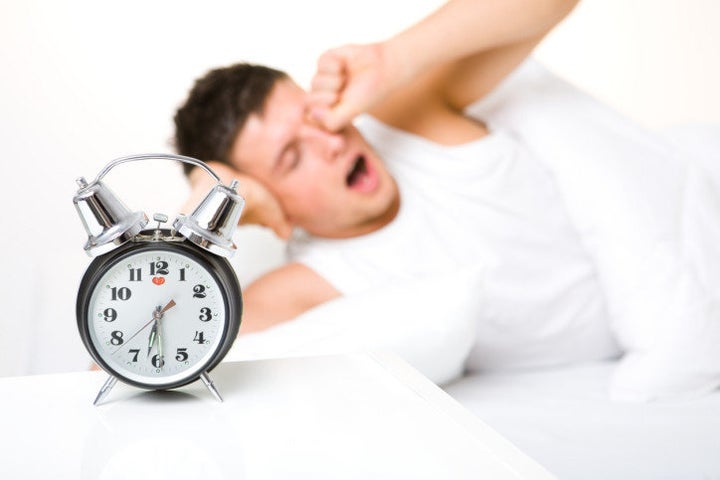
Several years ago a mother, father and their 17-year-old son came to our sleep clinic to discuss the son's "sleeping problem." A senior in high school, the teenager had missed about 50 percent of his first period classes and was in danger of failing. According to his mother, the problem was simple: "He cannot get up in time for school."
His father was less concerned. Dad believed the problem was also simple -- his son was a "slacker" and just needed to go to bed on time. Weeks before their appointment, the son's sleep problems had resulted in a somewhat tumultuous home situation with the police having to break up a family disturbance. Dad, tired of trying unsuccessfully to wake up his "slacker" son each morning, threw a bucket of ice water on him. Obviously shocked (and cold), the son jumped out of bed and began punching his father, while mom looked on and called 911.
Not all presentations of this scenario are quite so dramatic, but many do involve family discord. After obtaining a complete sleep history, it was apparent that this young man was not lazy or oppositional -- he had Delayed Sleep Phase Syndrome (DSPS).
DSPS is a circadian rhythm disorder affecting the timing of the brain's sleep-wake clock. Individuals with DSPS are unable to fall asleep earlier than their usual sleep time, despite being sleep deprived from staying up the night before.
DSPS is a disorder that affects 7-16 percent of children and teenagers. The causes of DSPS have not been confirmed although most sleep specialists believe it may be an exaggerated reaction to the normal shift in internal clocks that adolescents experience during puberty.
Most of us have an internal clock that runs slightly longer than 24 hours, resulting in a natural tendency to delay sleep. Environmental factors such as social routines, timing of meals and exposure to light serve to reset the clock to keep it stable. Sensitivity to environmental factors that regulate the sleep-wake cycle may be attenuated in adolescence. DSPS often runs in families, so if you were a night owl during your teenage years, your son or daughter may inherit a similar sleep pattern.
Are you constantly dragging your son or daughter out of the bed? The symptoms of DSPS include:
Inability to Fall Asleep Before 2 or 3 a.m. Many individuals with DSPS first believe they are insomniacs. For teenagers, the inability to initiate sleep at conventional hours may be exacerbated by social pressure to communicate throughout the night via cell phones or computers.
Inability to Wake Up On Time for School or Work. While most people do not jump out of bed each morning when their alarm goes off, a person with DSPS will often sleep through multiple alarms and be very difficult to arouse even if given substantial incentives to do so.
Excessive Daytime Sleepiness. A common complaint of DSPS is the overwhelming feeling of sleepiness in the morning and up to the early afternoon. Sleeping during morning classes is a common sign.
Depression and Drug Abuse. Children and teenagers with DSPS are more likely to experience depression and other behavioral problems.
If you believe your son or daughter has DSPS, contact your family doctor or a sleep specialist. Most sleep specialists will suggest keeping a sleep diary, allowing both the doctor and the patient to gain a quick, clear understanding of sleep-wake patterns. A sleep study is not required to make the diagnosis.
Once diagnosed with DSPS, treatment options may include:
Light Therapy. Exposure to a bright light will help naturally reset your child's internal clock and advance the circadian rhythm. Sitting in a sunlit room or taking a walk in the morning is effective. However, that might not be practical given the sunrise schedule and/or weather conditions. There are several good commercially available light boxes, also used for treating Seasonal Affective Disorder (SAD). Physicians most often recommend turning on the light box for around 30 minutes in the morning. The production of sleep regulator melatonin is inhibited by light, helping your child wake up earlier and on time.
Schedule Adjustment. Depending on your child's natural sleep rhythm, DSPS may be controlled by slight, incremental changes in bed time. If your child normally falls asleep around 1 am when he or she needs to be asleep by 11, set the bedtime to 12:45 one night, 12:30 the next night, and so on until the child is naturally falling asleep by the target time. For children who fall asleep too early, the same practice can be followed by setting the bedtime 15 minutes ahead each night.
Good Sleep Hygiene. The most important part of restful, healthy sleep is a consistent sleep-wake routine. Those at risk of or with DSPS should adopt a regimented sleep schedule, going to bed and waking up at the same time each day. Limit the child's exposure to stimulants such as caffeine and sugar as well. In the bedroom, try to keep it as cool and quiet as possible. Limit their exposure to sensory-awakening activities like television and video games in the evening.
Medication. There are no FDA-approved drugs for the treatment of DSPS. A sleep doctor may recommend a low dose of melatonin to be given in late afternoon or early evening in addition to bright light exposure.
As your son or daughter continues to develop, he or she will most likely outgrow DSPS. However, it is important to treat the condition, once diagnosed, to ensure that your child is receiving the proper amount of rest throughout all developmental stages. Teenagers needs 8-9 hours of sleep each night.
For more information on DSPS and treatment options, visit the National Sleep Foundation at www.sleepfoundation.org.